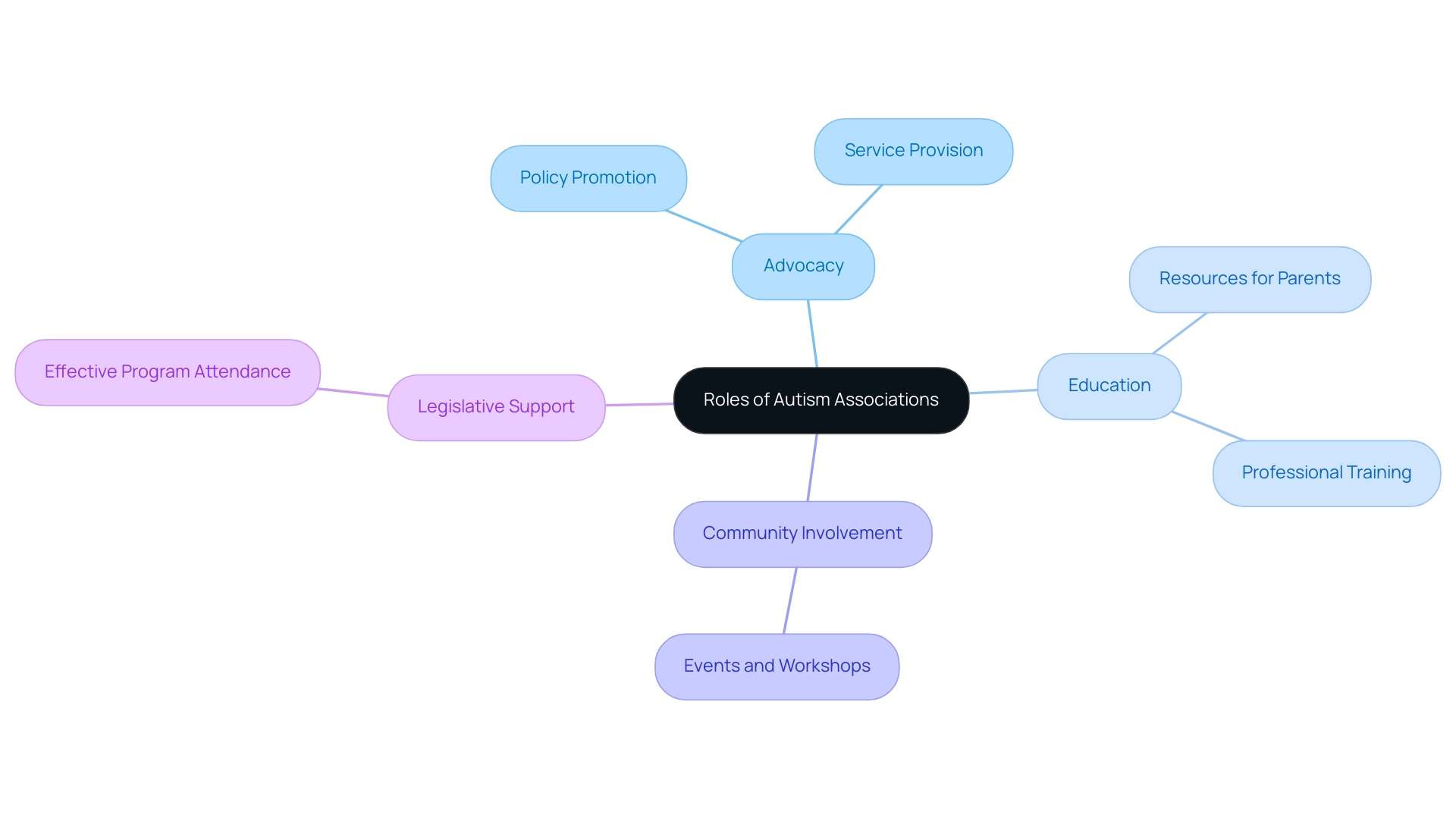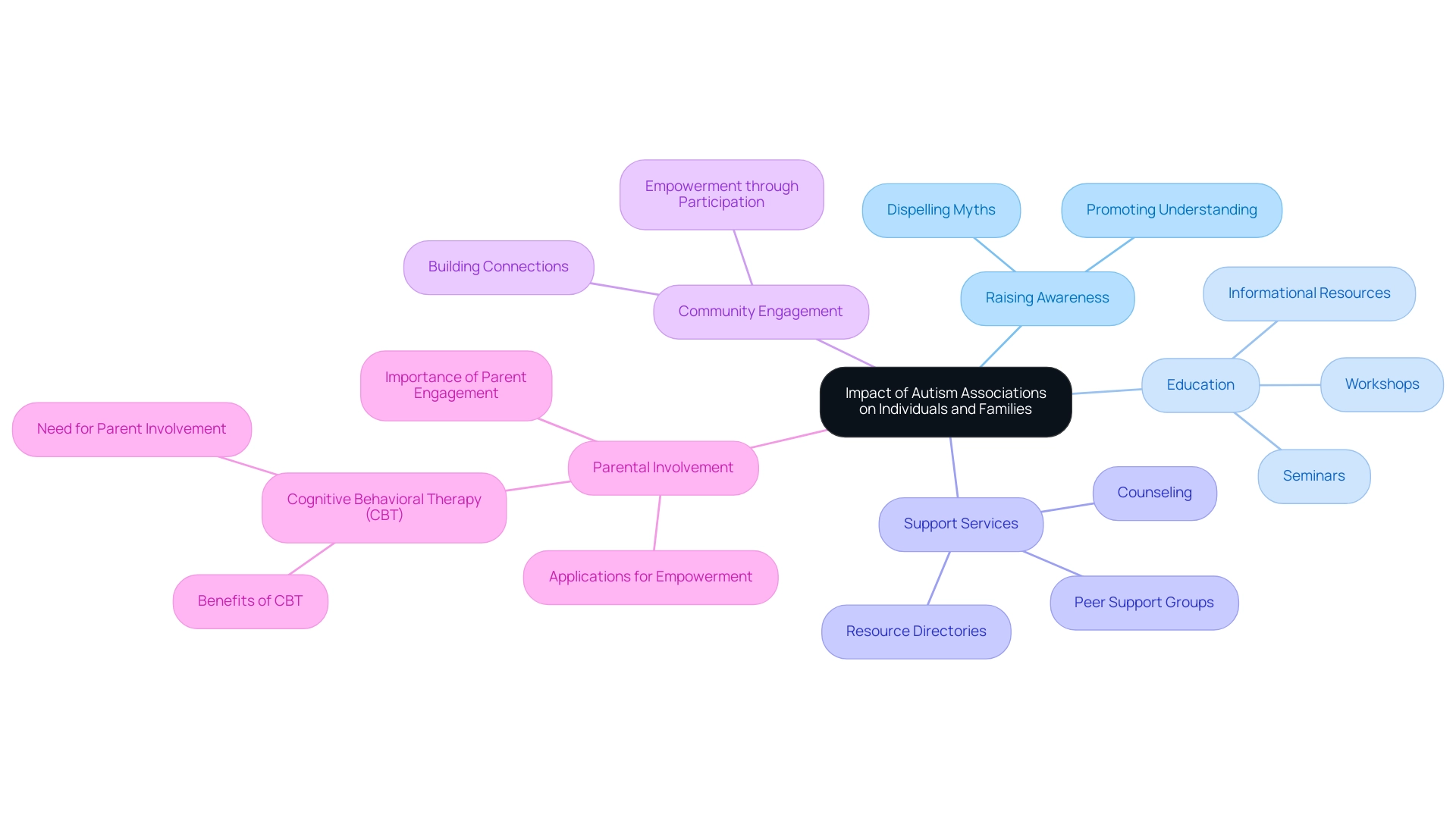Introduction
In a world where approximately 1 in 36 children are diagnosed with autism spectrum disorder, autism associations emerge as essential lifelines for families navigating this complex journey. These organizations not only advocate for the rights of individuals with autism but also serve as vital sources of education and community support. By providing resources that empower parents and caregivers, they play a crucial role in fostering understanding and acceptance of autism within society. As awareness grows and misconceptions are challenged, the significance of these associations becomes increasingly clear—offering not just information, but a sense of belonging and hope to families striving for a brighter future. Through advocacy, education, and community engagement, autism associations are reshaping the landscape of support, ensuring that no family faces the challenges of autism alone.
Defining Autism Associations: Purpose and Significance
The autismassociation serves as an essential lifeline for organizations supporting individuals with autism spectrum disorder (ASD) and their families, emphasizing advocacy, education, and community assistance. The autismassociation and similar organizations are instrumental in championing the rights and needs of those affected by developmental disorders, providing a wealth of resources that empower parents and caregivers. As highlighted by Laura NG, MA BCBA Clinical Operations Manager,
According to the CDC, approximately 1 in 36 children in the US is diagnosed with a spectrum disorder.
This statistic highlights the essential need for supportive networks that the autismassociation provides for individuals on the spectrum. Historically, in 2000, the prevalence was 6.7 per 1,000 children, or 1 in 150, illustrating the growing need for these organizations as awareness and diagnosis rates increase. By promoting relationships among households, experts, and supporters, the autismassociation cultivates a supportive and welcoming atmosphere that improves understanding and recognition of the condition.
Through the autismassociation, they not only provide essential information but also promote early intervention, which has proven to lead to improved outcomes in communication, social interaction, and adaptive behaviors for children with ASD. Additionally, the impact of Applied Behavior Analysis (ABA) therapy extends to the entire household, reshaping how they communicate, cope, and thrive together. Addressing misconceptions about the condition, such as the false beliefs surrounding intelligence and the debunked link between vaccines and the disorder, is crucial for promoting accurate information and understanding.
The influence of these groups, such as the autismassociation, reaches beyond separate households, transforming shared awareness and assistance for developmental disorders. As we keep observing the changing environment of support for individuals on the spectrum, the autismassociation's function remains crucial in ensuring that households are prepared to manage the intricacies of the condition and flourish together.
The Multifaceted Roles of Autism Associations
The autism association acts as a crucial foundation within the community, providing important functions that include promotion, education, and support services. These organizations are leading the charge in promoting policy changes that directly support individuals on the spectrum and their relatives, ensuring that their voices are heard in legislative discussions. This commitment to advocacy is critical; data reveals that youth in states like Wisconsin receive an average of 2.14 more services compared to their counterparts in Tennessee, highlighting the importance of localized advocacy efforts.
In addition to advocacy, associations provide invaluable educational resources tailored for both parents and professionals. These resources enable households by providing them with crucial information and efficient methods for understanding the condition. Dr. David Amaral observes, 'However, the researchers conclude that there is no clear and consistent pathology that has emerged for this condition,' adding that 'recent studies emphasize that the time course of brain development rather than the final product is most disturbed in this disorder.'
This understanding emphasizes the importance of ongoing education and assistance, particularly given that many individuals on the spectrum have unique interests or skills in fields like music, mathematics, or art, which can be cultivated through focused educational initiatives.
Community involvement is another essential role of organizations supporting individuals on the spectrum, as they arrange various events, workshops, and support networks intended to promote connections among households. These gatherings promote a sense of belonging and shared experience, reinforcing the notion that no one is alone in their journey. By actively involving families in these initiatives, autism associations enhance community connections and support networks, ultimately leading to a more informed and empowered autism association community.
Furthermore, the case study titled 'Stratification in Legislative Support Programs' suggests that legislative support programs may benefit from limiting attendance to parents with prior experience in this area. This approach could enhance the effectiveness of such programs by ensuring participants have relevant support experience. As the terrain of advocacy for developmental disorders continues to evolve, these organizations remain unwavering in their dedication to support households and enhance results through education and collaborative efforts.

Impact of Autism Associations on Individuals and Families
The impact of developmental disorder organizations on individuals and households is both significant and life-changing. With around 1 in 54 children in the United States diagnosed with spectrum disorder (ASD), the autismassociation plays a vital role in raising awareness and offering education. By dispelling myths and promoting understanding within society, associations not only empower households but also create a more informed community.
Through a variety of workshops, seminars, and informational resources, they equip families with the essential knowledge and skills necessary to advocate effectively for their children.
Moreover, the support services provided—spanning from counseling and peer support groups to extensive resource directories—are essential tools in navigating the complexities of the condition. It is significant that over 30% of individuals on the spectrum are diagnosed with depression, which underscores the essential need for strong support systems that related organizations offer. Families frequently convey that their participation with support groups for individuals on the spectrum has greatly improved their sense of empowerment and connection.
As one parent stated, "The autismassociation has been a lifeline, offering not just resources but also a community of understanding and support."
The importance of parental involvement in treatment is also critical; research indicates that while cognitive behavioral therapy (CBT) can benefit children with ASD, it often lacks sufficient parent engagement. Developing applications that empower parents can enhance treatment effectiveness and facilitate daily skill application at home. In this context, initiatives like those presented in Stephanie Carlier's work, which states, "This paper is an extended version of our conference paper 'Using a Serious Game to Reduce Stress and Anxiety in Children with Autism Spectrum Disorder' published in Proceedings of the 13th EAI International Conference on Pervasive Computing Technologies for Healthcare, Trento, Italy, 20–23 May 2019," highlight innovative approaches to reduce stress and anxiety for children with developmental disorders.
Furthermore, user data collected during gaming sessions and sent to the server in JSON format for retrieval in the Space Control app can provide valuable insights into the effectiveness of these serious games, further illustrating the positive impact of autismassociation in fostering resilience and community among families.

Conclusion
Autism associations play an indispensable role in supporting families affected by autism spectrum disorder, addressing the growing need for advocacy, education, and community engagement. With a significant number of children diagnosed with autism, these organizations not only champion the rights of individuals but also empower parents and caregivers with the knowledge and resources necessary to navigate their unique challenges. By fostering connections among families and professionals, they create an inclusive environment that enhances understanding and acceptance of autism in society.
The multifaceted contributions of autism associations extend beyond mere support; they actively advocate for policy changes, provide tailored educational resources, and organize community events that strengthen familial bonds and networks. Through these initiatives, families gain a sense of belonging and shared experience, reinforcing the message that no one faces the journey of autism alone. The positive impact of these organizations is further evidenced by the transformative experiences reported by families who find community, understanding, and hope through their involvement.
In a world where misconceptions about autism still persist, the work of autism associations is vital. By dispelling myths and providing critical support services, they not only empower families but also educate the broader community, paving the way for greater acceptance and inclusion. As the landscape of autism advocacy continues to evolve, these associations remain steadfast in their mission to uplift families, ensuring that every child with autism has the opportunity to thrive within a supportive and informed community.
Frequently Asked Questions
What is the primary role of the autismassociation?
The autismassociation serves as a vital resource for organizations supporting individuals with autism spectrum disorder (ASD) and their families, focusing on advocacy, education, and community assistance.
How prevalent is autism spectrum disorder in children in the US?
According to the CDC, approximately 1 in 36 children in the US is diagnosed with a spectrum disorder, indicating a significant need for supportive networks like the autismassociation.
How has the prevalence of autism changed over the years?
In 2000, the prevalence of autism was reported as 6.7 per 1,000 children, or 1 in 150, showing an increase in awareness and diagnosis rates over the years.
What benefits does the autismassociation provide to families and caregivers?
The autismassociation offers a wealth of resources that empower parents and caregivers, promotes early intervention, and improves outcomes in communication, social interaction, and adaptive behaviors for children with ASD.
What is the significance of Applied Behavior Analysis (ABA) therapy in relation to ASD?
ABA therapy positively impacts not only the children with ASD but also reshapes how their entire household communicates, copes, and thrives together.
Why is it important to address misconceptions about autism?
Addressing misconceptions, such as false beliefs surrounding intelligence and the debunked link between vaccines and autism, is crucial for promoting accurate information and understanding of the condition.
How does the autismassociation influence the broader community?
The autismassociation fosters shared awareness and assistance for developmental disorders, transforming the support environment for individuals on the spectrum and their families.




